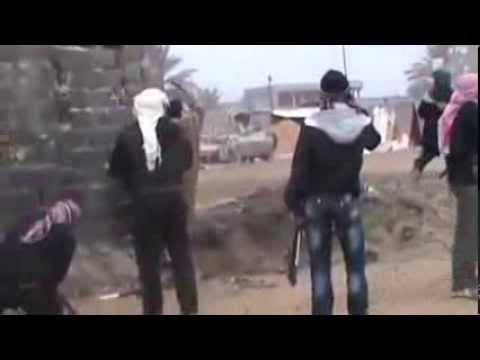On Christmas Day, Iraqi Prime Minister Nouri al-Maliki spoke to his country. He began, appropriately enough, talking about Jesus. He wished Christians a Merry Christmas, extended to “all Muslims, who believe in Jesus the Messiah, messenger of humanity and peace.” Holiday greetings out of the way, the prime minister moved on to what he really wanted to address. He spoke of ongoing counter-terrorist operations, and the need for tribal support. Maliki then talked about “what is referred to as the ‘sit-in protest,’ which has become a base for the leaders of al Qaeda,” repeating the phrase twice. This was a reference to the protest site near Ramadi, the symbolic center of the mainstream Sunni protest movement countrywide.
Maliki went on, saying “this we know because they have openly appeared on the podium, declaring we are al Qaeda, and we cut off heads. They have openly raised the banner of al Qaeda at the podium, and soon we will air the confessions” of terrorists admitting they are based at the site. “Our intelligence from aerial and human sources inside the site, confirm the presence of both Iraqi and foreign al Qaeda leaders. The provincial government has also confirmed that there are 36 al Qaeda leaders based there. So now there is a popular demand that the site be shut down.”
With national elections set for April, Maliki’s Christmas speech, a show trial-like airing of “confessions” by detainees on state television, and a wide-ranging media campaign in the days that followed were part of an effort to tie Ramadi protests to al Qaeda. The case was largely wrong, and to an extent made in bad faith. This and the December 30, 2013 bulldozing of the Ramadi encampment were among several actions that led to the total breakdown in security in Anbar province at year’s end and exacerbated the security crisis there.
However, the roots of the current crisis go back over the past year.
VIDEO: Insurgents in Anbar Overrun Iraqi Military Vehicles
***
The Sunni protest movement began in late 2012 following the arrest of aides to then-Finance Minister Rafia al-Isawi and threats to arrest him. Isawi is from Fallujah, the volatile city in east Anbar. The protesters took a Ramadi encampment they called “Pride and Dignity Square” as their center, and quickly spread to other Sunni provinces. The protests were far larger than any Iraq had seen since 2003, and they quickly came to dominate the national political debate.
While the protests were framed as spontaneous citizen reactions, and for many participants they genuinely were, each protest site was run by political parties, or at more radical sites, by insurgent front groups. The Ramadi site was dominated by two forces, both part of Speaker Osama al-Nujayfi’s Mutahidun, the state’s largest Sunni Arab coalition. One was the “Popular Committees,” a group headed by tribal “Awakening” leader Ahmad Abu Risha, and apparently run day-to-day by his nephew, Muhammad Khamis Abu Risha. The other was the Anbar Coordinating Committee, controlled by Ahmad al-Alwani of the Islamic Party. Nujayfi’s allies worked hand-in-glove with the Sunni clerical establishment, ensuring that their protests were the most well attended.
The second largest group of protest sites, mostly located in north-central and northwestern Iraq, was run by a front group for the Baathist Jaysh Rijal al-Tariqa al-Naqshbandia (JRTN), which is headed by Izzat al-Duri, a former Saddam Hussein deputy. The remainder of the sites were run by an eclectic mixture of insurgent fronts and activist organizations. The Islamic State of Iraq and al-Sham (ISIS), formerly known as al Qaeda in Iraq, had a notable presence only in Fallujah. Although a formal list of demands was published and accepted as “the demands of the protesters,” the document was drafted by the Ramadi leaders, and both Iraqi and pan-Arab media gave Ramadi disproportionate coverage.
The movement never had a serious chance of achieving its stated goals. It stated its demands absolutely, and was too sweeping, demanding a total abolition of de-Baathification and repeal of the death penalty for terrorism, which no Shiite prime minister would accept. Although the Ramadi site’s speakers were not al Qaeda, their message was infused with themes of Sunni power and identity, they flew old Iraqi flags with the three stars of the Baath Party, and speeches sometimes contained anti-Shiite epithets. Within a few months, attendance began to trail off.
Despite the movement not being a serious threat to his government, Maliki reacted badly at first, threatening to shut the Ramadi site down by force, saying “bring it to an end, before it is brought to an end for you.” After a rebuke from the Ayatollah Ali al-Sistani, Iraqi senior Shiite religious authority, Maliki quickly reversed course and said he would follow Sistani’s direction that the government fulfill protester demands as long as they are consistent with the law and constitution.
Political leaders established two committees in January 2013: a party committee and a ministerial committee. The latter achieved real albeit limited results, releasing about 3,000 Sunni prisoners. A more sweeping set of statutory reforms was proposed in March, including a significant softening of de-Baathification and other measures. But in return, Maliki demanded a formal ban on the Baath Party. With provincial elections scheduled for April and Shiite rivals attacking him over the compromise, Maliki wanted cover.
The main Sunni backer of the deal, Deputy Prime Minister Saleh al-Mutlak, was a political rival to the Mutahidun. Therefore, the wing of the protesters that was in the political process refused to back the deal, unwilling to give Mutlak a victory before the elections, and the bills stalled. Maliki’s coalition lost seats in the election, held throughout Shiite provinces on April 20, and the last effort to meet protester demands politically died at that point.
Yet that week a tragic event occurred that would both re-energize the Sunni protests and push them in a more dangerous direction.

